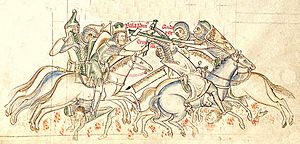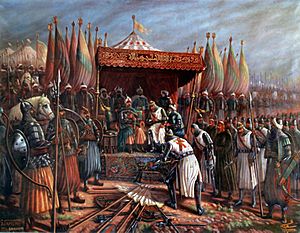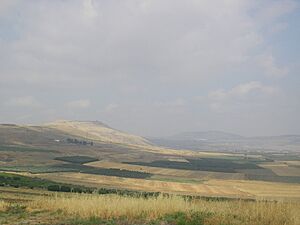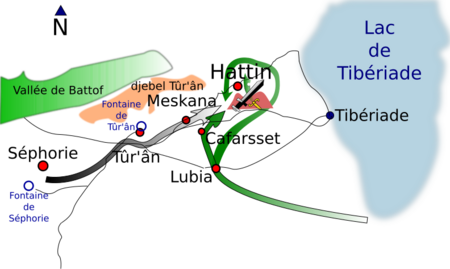Battle of Hattin facts for kids
Quick facts for kids Battle of Hattin |
|||||||
|---|---|---|---|---|---|---|---|
| Part of the Wars of the Crusader States | |||||||
 The Battle of Hattin, from a 13th-century manuscript of the Chronica Majora. |
|||||||
|
|||||||
| Belligerents | |||||||
| Commanders and leaders | |||||||
| Strength | |||||||
|
18,000 - 20,000 men
|
20,000-40,000 men
|
||||||
| Casualties and losses | |||||||
|
Most of the army 200 captured knights executed Captured turcopoles executed Captured infantrymen enslaved |
Light, mostly spearmen and some archers | ||||||
The Battle of Hattin was a major battle that happened on July 4, 1187. It was fought between the Christian Crusader states and the Muslim army led by Saladin, a powerful sultan. The battle is also called the Battle of the Horns of Hattin because it took place near a unique double-peaked hill.
In this battle, Saladin's Muslim armies won a huge victory. They captured or killed most of the Crusader forces. This defeat greatly weakened the Crusaders. As a result, Saladin's forces became the main power in the Holy Land. They quickly recaptured Jerusalem and many other Crusader cities and castles. These Christian losses led to the Third Crusade, which started two years later.
Contents
Where did the Battle of Hattin happen?
The battle took place near Tiberias in what is now Israel. The battlefield was close to a village called Hittin. Its most important feature was a double hill known as the "Horns of Hattin". This hill was next to a pass through the northern mountains. This pass connected Tiberias with the road from Acre to the east. An old Roman road, called Darb al-Hawarnah by the Arabs, was the main route here. It linked the Jordan River crossings, the Sea of Galilee, and the Mediterranean coast.
Why did the Battle of Hattin happen?
In 1186, Guy of Lusignan became the king of Jerusalem. His wife, Sibylla, was the queen. At this time, the Christian Kingdom of Jerusalem was divided. There were two main groups:
- The "court faction" supported King Guy. This group included newer arrivals like Raynald of Châtillon and the Knights Templar.
- The "nobles' faction" was led by Raymond III of Tripoli. He had been a regent (a temporary ruler) for the previous child-king. Raymond did not want Guy to be king.
Meanwhile, Saladin had become a very powerful leader. He controlled large areas to the south and east of the Crusader states. He united his people under Sunni Islam and wanted to push the Christian Franks out of Jerusalem. Saladin often made peace agreements (truces) with the Franks when he had other problems to deal with. One such truce was made in 1185.
In 1187, Raynald of Châtillon attacked a Muslim group traveling for a religious pilgrimage (Hajj). This happened while the truce with Saladin was still in place. Saladin was very angry and swore he would kill Raynald for breaking the peace. Saladin sent his son and another leader to attack Frankish lands near Acre.
In May 1187, the Templars fought Saladin's forces in the Battle of Cresson. The Templars suffered a heavy defeat, losing many knights and foot soldiers. This loss greatly hurt the Crusader army's strength and morale.
In July, Saladin began to attack Tiberias. Raymond III's wife was trapped inside the city. Despite this, Raymond advised King Guy not to fight Saladin directly. He thought Saladin's army would not stay away from their homes for long. The Knights Hospitaller also told Guy not to provoke Saladin.
However, Gerard de Ridefort, a leader of the Templars, told Guy to attack Saladin. King Guy listened to Gerard. This was a big risk for Guy, as he left only a few knights to defend Jerusalem.
The Siege of Tiberias
In late May, Saladin gathered his largest army ever on the Golan Heights. It had about 40,000 men, including 12,000 regular cavalry. He crossed the Jordan River on June 30. Saladin also gained the help of the Druze community from Sarahmul.
The Crusader army gathered at La Saphorie. This was a well-protected place with plenty of water. The Crusader force had about 18,000 to 20,000 men. This included 1,200 knights and about 10,000 foot soldiers. They also had crossbowmen and many hired soldiers. The army's main flag was the True Cross, a very important Christian relic.
Saladin wanted to trick King Guy into moving his army away from their safe camp at La Saphorie. He believed it would be easier to defeat them in an open battle than by attacking their strong forts. On July 2, Saladin attacked Raymond's fortress of Tiberias. Within a day, one of the fortress's towers fell. Saladin's troops stormed in, killing some defenders and taking others prisoner. Raymond's wife held out in the castle's inner fort.
As Saladin's troops prepared to attack the inner fort, he heard that Guy was moving the Crusader army. The Crusaders had fallen for Saladin's trap. King Guy's decision to leave La Saphorie was made after a meeting on July 2. Raymond argued that marching to Tiberias was exactly what Saladin wanted. He said La Saphorie was a strong place to defend. Raymond even said he was willing to lose Tiberias for the safety of the kingdom. But Gerard and Raynald accused Raymond of being a coward. This made King Guy decide to attack Saladin at Tiberias right away.
The Battle Begins
On July 3, the Frankish army started marching towards Tiberias. Muslim archers constantly attacked them. They passed some springs, but there wasn't enough water for the whole army. By midday, Raymond of Tripoli realized they wouldn't reach Tiberias by night. He and Guy agreed to change direction towards the Springs of Kafr Hattin, which were only about 6 miles away. From there, they could go down to Tiberias the next day.
However, the Muslims placed themselves between the Frankish army and the water. So, the Franks had to camp overnight on a dry plateau near the village of Meskenah. The Muslims surrounded their camp very closely. The Franks were tired and very thirsty. Saladin's men, however, were excited for victory.
Throughout the night, the Muslims made the Crusaders even more tired. They prayed, sang, beat drums, and set fire to the dry grass. This made the Crusaders' throats even drier. The Muslim army, on the other hand, had camels bringing water from Lake Tiberias.

On the morning of July 4, the Crusaders were blinded by smoke from the fires set by Saladin's forces. Muslim archers on horseback attacked the Franks. They had been given 400 loads of arrows during the night. Gerard and Raynald told Guy to form battle lines and attack.
Thirsty and tired, the Crusaders tried to move towards the springs of Hattin. But Saladin's army blocked their way forward and any escape. Count Raymond tried to break through to the water supply at Lake Tiberias twice. His second attempt allowed him to reach the lake and escape to Tyre.
After Raymond escaped, King Guy's situation became very bad. Most of the Christian foot soldiers ran away to the Horns of Hattin. They did not fight anymore. Many of Guy's soldiers were killed right there because they were so thirsty and wounded. The rest were taken prisoner. The Crusaders were completely surrounded. Despite three desperate attacks on Saladin's position, they were broken and defeated.
Saladin's 17-year-old son, al-Afdal, saw the battle. He later said: "When the king of the Franks [Guy] was on the hill with that band, they made a strong charge against the Muslims facing them, so that they pushed them back to my father [Saladin]. I looked at him and he was very sad and pale. He grabbed his beard and moved forward, shouting 'Don't believe the Devil!' The Muslims gathered, returned to the fight, and climbed the hill. When I saw that the Franks pulled back, chased by the Muslims, I shouted with joy, 'We have beaten them!' But the Franks gathered and charged again like the first time and pushed the Muslims back to my father. He did as he had done before and the Muslims turned on the Franks and pushed them back to the hill. I again shouted, 'We have beaten them!' but my father turned to me and said, 'Be quiet! We have not beaten them until that tent [Guy's] falls.' As he was speaking to me, the tent fell. The sultan got off his horse, bowed down to thank God, and cried with joy."
What happened to the captured Crusaders?

Many important Crusader leaders were captured after the battle. These included King Guy, Raynald of Châtillon, Gerard de Ridefort, and others.
King Guy and Raynald of Châtillon were brought to Saladin's tent. Saladin offered Guy water. In Muslim culture, offering water to a prisoner meant they would be spared. But Guy didn't know this. Guy passed the cup to Raynald. Saladin knocked it from his hands and said, "I did not ask this evil man to drink, and he would not save his life by doing so." He then accused Raynald of breaking the truce.
Some reports say Saladin himself then killed Raynald with his sword. Others say Saladin hit Raynald as a sign for his bodyguards to cut off his head.
After the Battle
Crusader Losses
The True Cross, which was carried into battle, was supposedly fixed upside down on a spear and sent to Damascus.
King Guy of Lusignan was taken to Damascus as a prisoner. He was released in 1188. Other captured nobles were eventually set free after money was paid for them.
After Raynald of Châtillon was killed, Saladin ordered that the other captured nobles be treated well. However, all 200 of the Templar and Hospitaller Knights who were captured were killed on Saladin's orders. They were beheaded. Only the Grand Master of the Temple was spared.
Captured Turcopoles (local horse archers who fought for the Crusaders) were also killed. Saladin believed they were Christians who had once been Muslim, which was a crime punishable by death in his state.
The rest of the captured knights and soldiers were sold into slavery.
The Crusader Kingdom Falls
On July 5, Saladin marched to Tiberias. Countess Eschiva, Raymond's wife, surrendered the castle. She was allowed to leave for Tripoli with her family and belongings. Raymond of Tripoli, who had escaped the battle, died later in 1187.
The Crusaders had used most of their soldiers in the Battle of Hattin. So, after the huge defeat, there were very few soldiers left to defend their castles and cities. Only about 200 knights escaped the battle. Because of this defeat, Saladin's forces quickly captured 52 towns and forts. By mid-September, Saladin had taken Acre, Nablus, Jaffa, Sidon, Beirut, and Ascalon.
The city of Tyre was saved by the arrival of Conrad of Montferrat. He helped defend it, and Saladin's attack on Tyre failed. Jerusalem was defended by Queen Sibylla and others. They later negotiated its surrender to Saladin on October 2.
Why was this battle so important?
News of the defeat at Hattin reached Rome. It is said that Pope Urban III died from the shock. His successor, Pope Gregory VIII, quickly called for a new crusade. This led to the Third Crusade, which began in 1189. The Third Crusade was successful in getting back many Christian lands. However, Christian control in the Holy Land remained weak for many years. The final collapse of Crusader power in the region happened much later, in the Battle of La Forbie in 1244.
See also
- 1177: Battle of Montgisard
- 1179: Battle of Marj Ayyun
- 1179: Battle of Jacob's Ford
- 1182: Battle of Belvoir Castle
- 1183: Battle of Al-Fule
- 1187: Battle of Cresson
Images for kids
-
The Battle of Hattin, as imagined by Gustave Doré.
-
A modern painting showing Saladin accepting the surrender of Guy of Lusignan.







